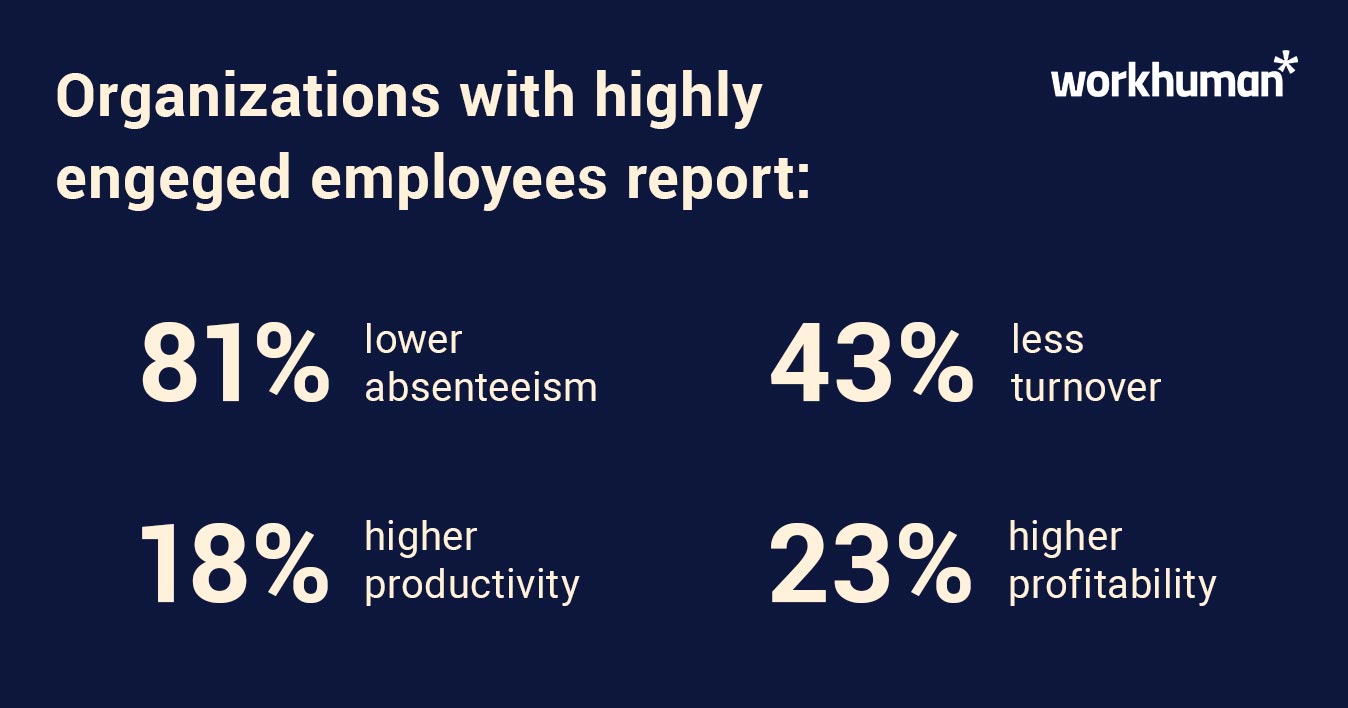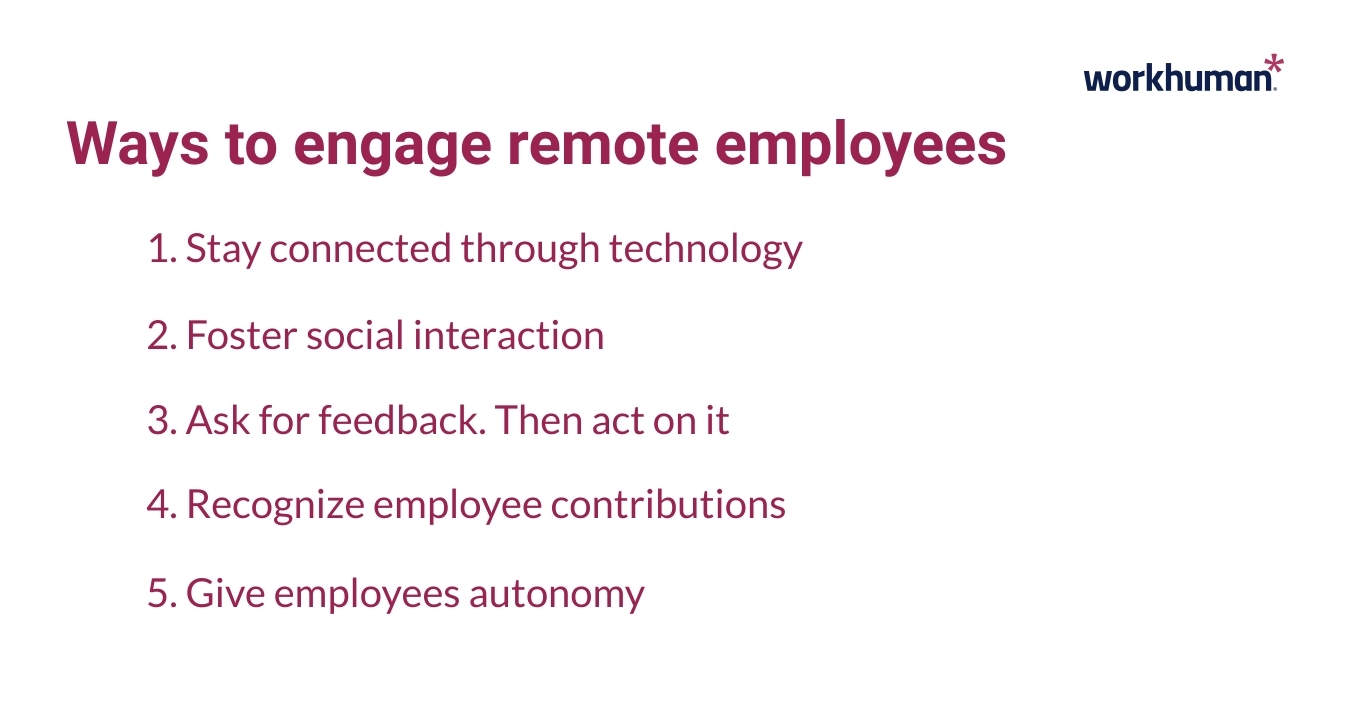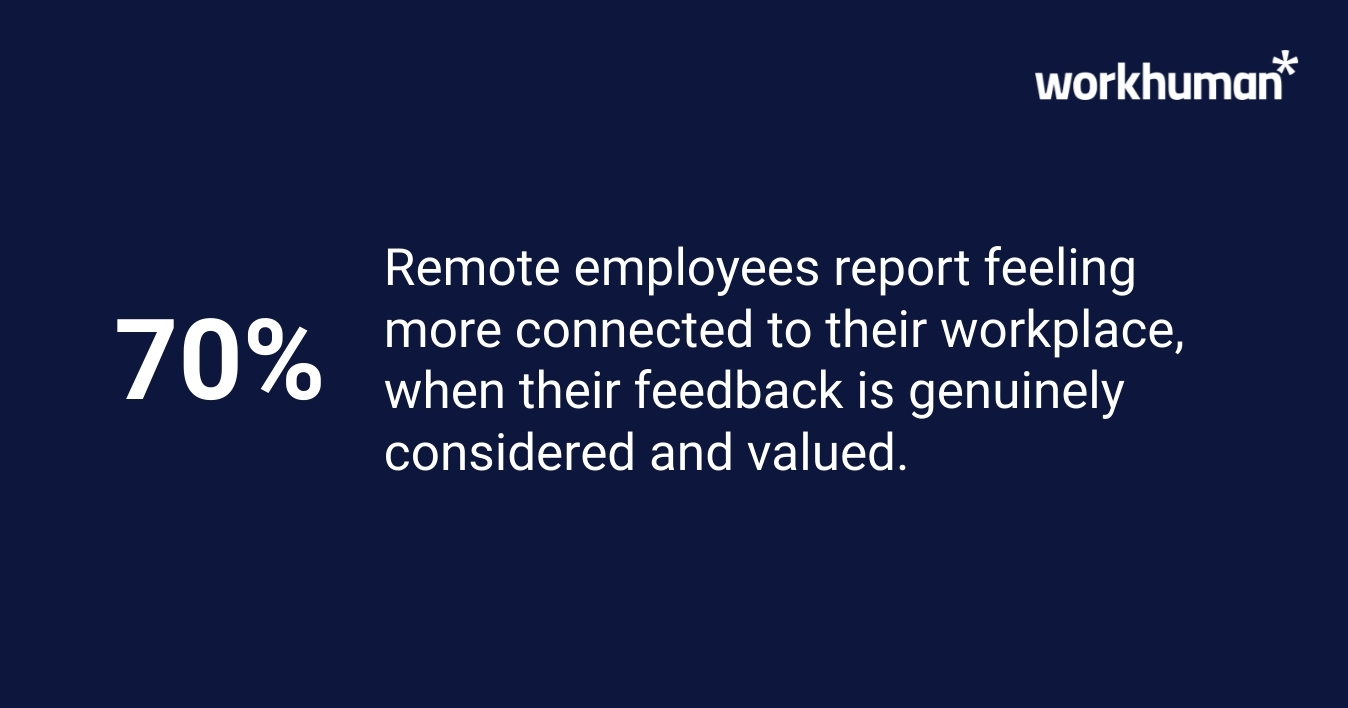How to Engage Remote Employees with Simple, Actionable Strategies
A 2022 Gallup research found that 60% of workers surveyed reported feeling emotionally detached from their work. This emotional detachment can significantly contribute to employee disengagement, a lack of productivity, and, ultimately, turnover.
As hybrid and remote work become more common, all companies must learn how to engage remote employees. This blog post will guide you through everything from tools that boost engagement to ways of building a work environment that welcomes everyone, no matter where they're working from.
Understanding remote employee engagement
According to GallupOpens in a new tab, businesses in the top quartile of employee engagement rates significantly outperform those in the bottom quartile on these business outcomes:
- 81% lower absenteeism
- 18% higher productivity
- 43% less turnover in low-turnover organizations
- 23% higher profitability

It is imperative for team leaders to help virtual workers feel connected, valued, and integral to their team and organization. This ensures that distance doesn't diminish an employee's involvement, productivity, or sense of belonging.
A two-year study by Great Place To Work, which looked at over 800,000 employees from Fortune 500 companies, found that working from home can boost productivity by up to 13%. This highlights how engaged employees positively affect productivity from home.
For additional employee engagement ideas, read "The 4 Es of Employee Engagement"
Why is it so important to engage remote employees?
Workhuman's® 2021 report, "One Year Into COVID: The Pandemic's Impact on How We Work" – a time when many people had been working from home in the previous year – found workers are feeling more anxious, isolated, overwhelmed, and less motivated over the course of the previous year. 59% cited a lack of human connection, which remote employees are certainly more prone to.
Because remote employees are not physically present with their teams, it takes more effort to weave them into the fabric of the company culture. However, it's crucial to make sure they feel seen and connected, just like everyone else.
When remote workers are fully engaged, they're more productive and less inclined to search for new employment opportunities. For organizations, this boost in productivity and reduction in turnover can lead to extensive cost savings.
While this data isn’t exclusive to remote workers, it paints a clear picture of the power employee engagement can have on work, and the remote workforce is no exception.
Ways to keep remote employees engaged
We understand the importance of engagement. We also recognize that creating and maintaining a culture of high engagement for the remote workforce can be challenging. So, where do you begin?

Consider these tips to enhance employee engagement within your organization, specifically for those working remotely.
Establish a robust onboarding process
Crafting a thorough onboarding process for new employees is key, as it lays the foundation for their journey within the company. A well-structured onboarding experience not only helps new hires feel welcomed and valued but also significantly impacts their decision to stay with the company long-term.
By effectively integrating remote workers from the start, companies can boost employee retention and build a more cohesive and committed team.
Nurture social connections and clear communication
It's crucial that all employees, particularly those who work remotely, have straightforward access to video conferencing tools for meetings and brainstorming sessions (think Zoom), along with an instant messaging platform to facilitate different types of interactions.
Platforms like Slack provide a venue for employees to communicate, both individually and in groups. These collaboration tools can be extremely effective in smoothing workflows and fostering bonds between employees.
Introduce a variety of activities to build social bonds among remote employees, like virtual coffee breaks or team-building and fun employee engagement games, to enhance camaraderie.
Emphasizing friendships and personal ties within remote teams can lead to higher productivity and engagement, as these connections foster a supportive and motivated work environment.
Provide frequent, timely recognition
All employees want to be recognized for their efforts and contributions. With remote teams, there's a risk that employees might feel their successes go unnoticed and unappreciated. Embedding recognition and appreciation into the culture's core can help employees excel, regardless of their location.
About 63% of employees say more recognition and appreciation make them more likely to stay in their roles, highlighting the importance of engagement strategies to improve retention. If companies can successfully figure out how to engage remote employees, the advantages can be extensive.
When employees see their work celebrated, they are three times more likely to feel appreciated and connected to the company's mission and values. This sense of belonging and recognition is key to nurturing a committed and productive remote workforce.
Regular acknowledgment not only fosters a culture of appreciation but also motivates employees to maintain or increase their level of effort. Frequent, specific recognition of employee achievements is crucial for boosting engagement, loyalty, and productivity among remote workers. Here are effective methods to recognize contributions:
Spot awards
Provide immediate recognition for outstanding efforts with small, timely rewards.
Public acknowledgment
Celebrate achievements during virtual team meetings or via company-wide newsletters.
Personalized notes
Send personalized thank-you notes or emails from managers or peers to highlight individual contributions.
Solicit feedback and implement changes
Soliciting feedback from remote employees isn't just helpful; it's essential. According to Workhuman research, when employees believe their feedback is genuinely considered, 70% report feeling more connected to their workplace.
By actively engaging in this dialogue, companies can not only enhance their strategies but also strengthen the sense of community and belonging among remote teams, a crucial component in maintaining high engagement levels across dispersed workforces.
Pulse surveys stand out as an excellent method for gauging employee engagement. By utilizing a pulse survey tool, leaders can assess and contrast the productivity, job satisfaction, and engagement rates across their entire workforce.
Upon analyzing the survey outcomes, it becomes possible for leaders to examine the differences in engagement among remote, hybrid, and office-based employees.
Should there be a noticeable disparity, with one group demonstrating significantly higher engagement, it's worthwhile to identify the successful strategies within that group. The goal, then, is to apply these effective practices more broadly to enhance engagement levels in the less engaged segments.
Promote health and wellbeing
Another great idea to fuel employee engagement would be to create a supportive environment for remote employees. It should encompass overall health and wellbeing. It is vital to encourage regular breaks during work hours, which helps reduce burnout and boost productivity.
Engagement doesn't happen overnight, but with 4 Powerful Ways To Fuel Employee Engagement you can actively engage your employees everyday.
Providing access to health resources, such as virtual wellness programs or subscriptions to a tool like a meditation app, supports mental and physical health.
Establishing a repository of wellbeing resources to ensure that employees have easy access to helpful information is another helpful strategy. This comprehensive approach not only enhances the wellbeing of employees but also strengthens their engagement and connection with the company.
Minimize the length of remote meetings
To keep remote meetings efficient and engaging, it's essential to prepare a clear and concise agenda prior to each discussion. This agenda should outline key points and allocate specific timeframes for each topic to ensure the meeting progresses smoothly and stays on point.
Encourage participants to prepare their inputs in advance based on the agenda, which minimizes deviations and keeps the meeting focused on predetermined goals. This method not only makes meetings more productive but also respects everyone’s time, which is crucial for maintaining high engagement levels among remote workers.
Cultivate a positive organizational culture
A positive organizational culture is cultivated through leadership, rewarding hard work, and encouraging open feedback. Providing ample career development opportunities also plays a critical role in nurturing a thriving culture. It's essential for leaders and teams to espouse the organization's core values.
- Integrate the values into performance evaluations, ensuring they are reflected in the criteria used for assessing employee contributions.
- Use these values as a basis for recognition programs, where employees are celebrated for actions that exemplify these ideals.
- Encourage managers to discuss core values in team meetings, making them a regular part of conversation and decision-making processes.
Encourage better work-life balance
Ensuring work-life balance is critical in remote settings, as blurred lines between home and work can lead to burnout and decreased productivity. When employees work from home, they may struggle with overworking and have difficulty disconnecting, which can impact their wellbeing and lead to faster burnout.
By following the steps below, employers can significantly improve remote employees' work-life balance, helping to create a healthier, more productive workforce.
Enforce defined work hours
Establish clear start and end times to help employees disconnect. Make it a policy not to schedule meetings or contact employees outside of these hours.
Offer flexible scheduling
Adapt work schedules to accommodate personal needs. This can help employees attend doctors' appointments, spend time exercising, care for their families, or work on their passion projects.
Encourage strong time management
Offer remote employees resources for effective time management to prevent overworking.
Foster a supportive culture
Cultivate a culture that respects employees' autonomy and independence, making it easier for employees to set boundaries.
Offer competitive compensation packages
Of course, one of the best ways to engage remote employees is to offer competitive compensation, which is vital for attracting and retaining top talent. A strong salary and benefits package not only signals that an organization values its staff but also positions it as a desirable place to work, which is essential in today's competitive job market.
This strategy is key to keeping remote employees motivated and committed to their roles, making it a fundamental aspect of effectively engaging remote workers.
Facilitate career advancement opportunities
Besides competitive compensation, clear pathways for career growth are essential. Facilitating career advancement opportunities not only supports professional development but also enhances employee satisfaction and retention. Organizations can take several proactive steps to support their remote workforce:
- Create career maps: Outline potential career paths within the company to help employees visualize their growth opportunities.
- Offer professional development: Provide access to courses, workshops, and training to expand skills and knowledge.
- Implement mentoring programs: Pair employees with mentors who can guide them through their career progression.
- Conduct regular reviews: Hold frequent performance evaluations to discuss achievements, areas for improvement, and future goals.
These initiatives demonstrate a commitment to the professional growth of remote employees, which is crucial for engaging and retaining top talent in a competitive landscape.
Conduct employee engagement surveys
Employee engagement surveys are a vital tool for understanding the needs and experiences of remote employees. They provide valuable insights that can help organizations tailor their strategies to improve job satisfaction and productivity.
Build, send, and act on employee engagement surveys with ease using our Guide to Employee Engagement Surveys.
According to recent data, organizations that regularly conduct surveys for employee engagement are 33% more likely to report increased employee performance.
With remote workers' feedback on various aspects of their experience, companies can identify areas for improvement and effectively address issues, leading to a more engaged and committed workforce.
This feedback loop not only benefits employees by acknowledging their input but also enhances organizational effectiveness.
Encourage peer feedback
Peer feedback facilitates just learning and development and also fosters a culture of accountability and open communication. Ensure your remote employees provide constructive feedback to each other. It enhances engagement by encouraging honest conversations and mutual respect.
This process helps employees understand their strengths and areas for improvement from a perspective different from that of their managers. Businesses can cultivate this environment by:
- Training employees: Equip employees with the skills to give constructive, respectful feedback.
- Creating formal mechanisms: Implement structured opportunities for peer feedback, such as during project reviews or regular feedback cycles.
Maintain frequent and transparent communication
Effective communication is essential to engage remote employees successfully. Ensuring open and frequent dialogue helps keep remote workers informed and connected to the company’s goals. Here are strategic methods to optimize communication:
- Record meetings: By recording all virtual meetings, you provide a resource for those who cannot attend live, helping engage remote employees who need to catch up on missed information.
- Utilize content management systems: These systems keep crucial documents and updates organized, making it easier for remote teams to stay aligned and engaged.
- Create company-wide chat channels: Establish specific channels for various projects and casual interactions, fostering a community environment that is vital for engaging remote workers.
These techniques not only improve transparency but also support ongoing efforts on how to keep employees engaged while working from home, enhancing overall productivity and satisfaction.

Leveraging Workhuman's solutions for remote work
Remote work depends on technology to bridge the gap between employees, their coworkers, and the company.
With businesses growing and employees moving, these technological solutions can do more than just gauge employee engagement — they can enhance it for everyone involved.
Foster better collaboration
Fostering collaboration and connection is vital not just for boosting employee morale but also for enhancing the company's overall performance.
Consider setting up channels for employee resource groups (ERGs) and shared hobbies, such as hiking, cooking, or movies. Wokhuman Conversations® could help you do that.
Ultimately, it’s essential for organizations to continually seek ways for employees to build connections with one another. The stronger these connections, the deeper their engagement.
Provide more frequent recognition
Employee recognition stands out as a crucial element in an organization's strategy.
So, what makes recognition effective, and how can leaders ensure they properly acknowledge their remote teams? The report highlights that meaningful recognition should be:
- Fulfilling
- Authentic
- Equitable
Recognition should touch every part of your organization, reaching every employee, no matter where they are located.
Utilizing a recognition platform such as Workhuman’s Social Recognition® allows you to gather data that can identify any disparities in the way or timing of recognition across different groups.
Conduct regular check-ins
In today's fast-paced environment, where situations can shift at a moment's notice, unpredictability also applies to employees. Therefore, it's vital for managers to frequently keep in touch with their team members to provide the support they need.
This is particularly important for remote employees. Managers are encouraged to set aside 30 minutes for a check-in session every other week—at a minimum. If possible, making this a weekly routine can be even more effective in engaging remote employees.
These check-in sessions offer a valuable development opportunity for managers and remote workers to align on performance objectives, explore project details and expectations, and strategize on the most effective ways to involve remote team members.
Come prepared with a list of check-in questions to make sure you tackle all the important points.
Celebrations
First and foremost, an employee is an individual with a life beyond their job, and they shouldn't be expected to disconnect from it when they enter the workplace or start up their computer.
Instead, it's important for employers to foster an environment where staff members across the company can celebrate and acknowledge each other's achievements, both professional and personal, from promotions to weddings and everything in between.
Check out Workhuman's Celebrations bundle here:

Conclusion
Engaging remote employees effectively hinges on strategic practices that foster connection, recognition, and growth. By fostering clear communication, recognizing contributions, and providing career development opportunities, companies can build a supportive and inclusive remote work environment.
Organizations might need to know ways to measure employee engagement. They can start by conducting regular engagement surveys and supporting work-life balance.
These measures not only boost productivity and loyalty but also create a thriving organizational culture that attracts and retains top talent, ensuring the success of remote teams in the dynamic work landscape.
About the author
Sarah Bloznalis
Sarah Bloznalis is a content marketing specialist at Workhuman from Dorchester, Mass.